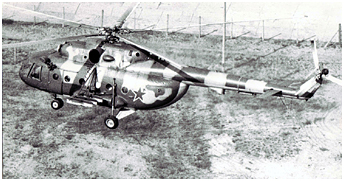
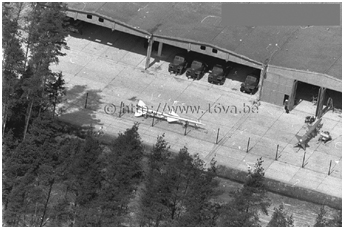 So we would first fly around to the north of the zone and photograph the Soviet barracks and transport helicopter base of Oranienburg where the
notorious Nazi concentration camp of Sachsenhausen was originally located. This had been in part preserved by the Soviets as a fearsome
reminder of the Fascist past of the GDR, as indeed had many other places that the local population would have preferred to forget. It is an interesting
thought that many Soviet officers did at that time genuinely believe that they were doing Europe a favour by keeping Germany divided.
Since there was very rarely any flying at Oranienburg, we would frequently turn to the north-east and try and keep trying to find the well
hidden East German SA-2 missile storage site located somewhere in the Schönwalde forest between the two small towns of
Lanke and Ladeburg (1).
I must admit that I hardly ever found this site and I know of other BRIXMIS officers who had the same problem as they came back with tales of the
Soviet fighter base at Finow despite the fact that it lay ten miles outside the BCZ. Having often failed to find the SA-2 storage site, we could usually
easily locate Bernau, where were located units of the 20th Guards Combined-Arms Army, one of the five armies making up the Group of Soviet Forces in Germany.
So we would first fly around to the north of the zone and photograph the Soviet barracks and transport helicopter base of Oranienburg where the
notorious Nazi concentration camp of Sachsenhausen was originally located. This had been in part preserved by the Soviets as a fearsome
reminder of the Fascist past of the GDR, as indeed had many other places that the local population would have preferred to forget. It is an interesting
thought that many Soviet officers did at that time genuinely believe that they were doing Europe a favour by keeping Germany divided.
Since there was very rarely any flying at Oranienburg, we would frequently turn to the north-east and try and keep trying to find the well
hidden East German SA-2 missile storage site located somewhere in the Schönwalde forest between the two small towns of
Lanke and Ladeburg (1).
I must admit that I hardly ever found this site and I know of other BRIXMIS officers who had the same problem as they came back with tales of the
Soviet fighter base at Finow despite the fact that it lay ten miles outside the BCZ. Having often failed to find the SA-2 storage site, we could usually
easily locate Bernau, where were located units of the 20th Guards Combined-Arms Army, one of the five armies making up the Group of Soviet Forces in Germany.
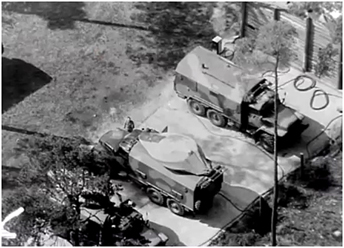 Système de communication troposphérique R-412 "Torf" monté sur un chassis Oural-375. Les deux antennes du complexe étaient repliées et bâchées. © BRIXMIS.
Système de communication troposphérique R-412 "Torf" monté sur un chassis Oural-375. Les deux antennes du complexe étaient repliées et bâchées. © BRIXMIS.
R-412 "Torf" tropospheric communication system mounted on an Ural-375 chassis. The two antennas of the complex were folded and covered. © BRIXMIS.
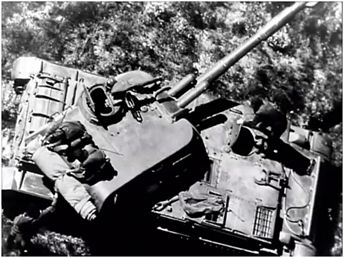 Obusier 2S3 "Akatsiya" de 152mm. © BRIXMIS.
Obusier 2S3 "Akatsiya" de 152mm. © BRIXMIS.
152mm 2S3 "Akatsiya" self-propelled howitzer. © BRIXMIS.
Here there was almost always some activity of interest. Often there would be new equipment being washed down on the wash stand or there would be a
demonstration of tracked vehicles showing all the equipment and more importantly all the different types and mix of ammunition that could be
carried. We discovered from a KGB defector, one Captain Myagkov, that the Army Commander at Bernau believed that the Chipmunk would only
appear when there was new equipment on show and he therefore demanded that this serious intelligence leak be plugged. In fact, on one occasion, we
believe that he had to be restrained from using his anti-aircraft weapons to shoot down the Chipmunk. The real truth was that, as Bernau was a very
fruitful target, I flew over it on almost every sortie but only rarely made several passes unless there was something of interest to see. This was my
experience when I managed to take the first aerial photographs with a 1000mm lens of the T-64 medium battle tank in 1976 while it was on the
wash stand. Normally, the Chipmunk was not noticed until the third pass and we tried not to antagonize the troops on the ground for obvious reasons,
unlike another Mission flight that managed to drop a camera lens in the middle of a crowded parade square.
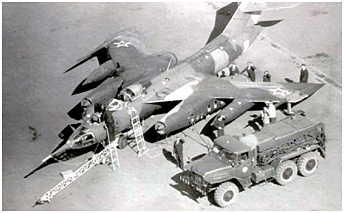
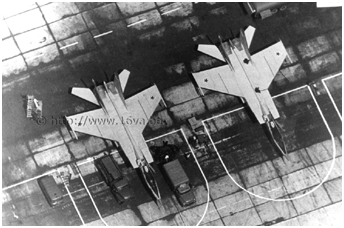 From Bernau we would turn south towards the Soviet air reconnaissance
base of Werneuchen to the east of the BCZ where both Yak-28 "Brewer" and MiG-25 "Foxbat" aircraft were based. Access to this airfield was almost
impossible by a ground tour as it was well inside the Permanently Restricted Area (PRA) that stretched as far as the Polish border. The nearest we could
get to it only allowed us to photograph aircraft as they turned onto base leg carrying out visual circuits on the easterly runway. The problem with that
was that the observation point (OP) was just about on the junction of two autobahns, the Berlin Ring and the Prenzlau autobahn, so we could never
stay very long before attracting the unwelcome attention of the East German Police (Volkspolizei) and we often spent time while airborne looking for a
more suitable OP for watching Werneuchen aircraft, but all to no avail since as far as I am aware we never did find anything better. Often the only
recourse open to us was to become "unsure" of our position and find ourselves inside the PRA (read >
Let's go get Foxbat!). It was important that we knew as much as possible about the
reconnaissance systems carried by the various versions of the "Foxbat" aircraft that were to be found at Werneuchen. The aircraft were capable of
a speed of Mach 3.0 up to a height of 70,000ft and continually carried out reconnaissance flights along the borders of the GDR and the Baltic. Not
only this but they were also thought to have a secondary nuclear capability that would have posed an even more serious threat in the event of a nuclear
war. Sometimes we were fortunate and managed to catch the aircraft out on the flight line when they were being prepared for a reconnaissance mission.
At other times there was only minimal activity and the ground crew used to wave at us.
From Bernau we would turn south towards the Soviet air reconnaissance
base of Werneuchen to the east of the BCZ where both Yak-28 "Brewer" and MiG-25 "Foxbat" aircraft were based. Access to this airfield was almost
impossible by a ground tour as it was well inside the Permanently Restricted Area (PRA) that stretched as far as the Polish border. The nearest we could
get to it only allowed us to photograph aircraft as they turned onto base leg carrying out visual circuits on the easterly runway. The problem with that
was that the observation point (OP) was just about on the junction of two autobahns, the Berlin Ring and the Prenzlau autobahn, so we could never
stay very long before attracting the unwelcome attention of the East German Police (Volkspolizei) and we often spent time while airborne looking for a
more suitable OP for watching Werneuchen aircraft, but all to no avail since as far as I am aware we never did find anything better. Often the only
recourse open to us was to become "unsure" of our position and find ourselves inside the PRA (read >
Let's go get Foxbat!). It was important that we knew as much as possible about the
reconnaissance systems carried by the various versions of the "Foxbat" aircraft that were to be found at Werneuchen. The aircraft were capable of
a speed of Mach 3.0 up to a height of 70,000ft and continually carried out reconnaissance flights along the borders of the GDR and the Baltic. Not
only this but they were also thought to have a secondary nuclear capability that would have posed an even more serious threat in the event of a nuclear
war. Sometimes we were fortunate and managed to catch the aircraft out on the flight line when they were being prepared for a reconnaissance mission.
At other times there was only minimal activity and the ground crew used to wave at us.
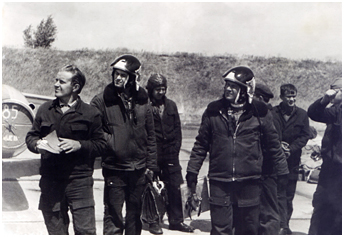
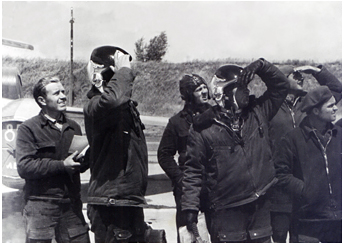 They did not seem to get at all annoyed with the presence of an
Allied aircraft over the airfield. I would almost go so far as to say that they were actually pleased to see us, at least compared with their Army
counterparts. I have no doubt that they also fully appreciated the display of aerobatics put on for their benefit by one of my colleagues who obviously
found the idea of carrying out such a display over an active Soviet airfield in the middle of the Cold War stimulating.
Apart from the resident aircraft, Werneuchen was also used frequently as a forward operating base for heavy bombers from the Soviet Union,
normally Naval Tu-22 "Backfire" aircraft from the Baltic Fleet Air Force.
These bombers used to come occasionally to the forward area as part of
deployment and mobility exercises and they would stay for two or three days before returning to the Soviet Union
(read > Long-range aviation visitors). We managed on more than one
occasion to obtain high quality close-up photography of the aircraft. This was one of the reasons that we visited Werneuchen on a regular basis.
However, this was not without its hazards, as the Chipmunk occasionally found itself accidentally in the middle of the 'Foxbat' visual circuit at
Werneuchen. In this situation it was not possible to leave the area owing to the speed differential that would have made it difficult even to try. So we
would have to fly a very small racetrack pattern around a convenient landmark until it was safe to fly off. There were never any complaints from
the Soviets about this less than ideal display of airmanship, they only ever seemed to complain about the Chipmunk flying too close to the civilian
airfield at Schönefeld even if we had been nowhere near it. The Soviets always pretended, even to themselves, that there was nothing of any
importance in the BCZ and drawing attention to Werneuchen would be admitting its importance.
They did not seem to get at all annoyed with the presence of an
Allied aircraft over the airfield. I would almost go so far as to say that they were actually pleased to see us, at least compared with their Army
counterparts. I have no doubt that they also fully appreciated the display of aerobatics put on for their benefit by one of my colleagues who obviously
found the idea of carrying out such a display over an active Soviet airfield in the middle of the Cold War stimulating.
Apart from the resident aircraft, Werneuchen was also used frequently as a forward operating base for heavy bombers from the Soviet Union,
normally Naval Tu-22 "Backfire" aircraft from the Baltic Fleet Air Force.
These bombers used to come occasionally to the forward area as part of
deployment and mobility exercises and they would stay for two or three days before returning to the Soviet Union
(read > Long-range aviation visitors). We managed on more than one
occasion to obtain high quality close-up photography of the aircraft. This was one of the reasons that we visited Werneuchen on a regular basis.
However, this was not without its hazards, as the Chipmunk occasionally found itself accidentally in the middle of the 'Foxbat' visual circuit at
Werneuchen. In this situation it was not possible to leave the area owing to the speed differential that would have made it difficult even to try. So we
would have to fly a very small racetrack pattern around a convenient landmark until it was safe to fly off. There were never any complaints from
the Soviets about this less than ideal display of airmanship, they only ever seemed to complain about the Chipmunk flying too close to the civilian
airfield at Schönefeld even if we had been nowhere near it. The Soviets always pretended, even to themselves, that there was nothing of any
importance in the BCZ and drawing attention to Werneuchen would be admitting its importance.
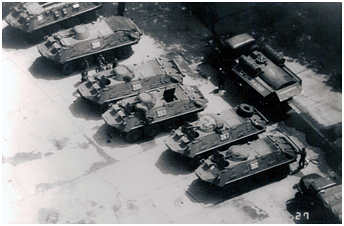
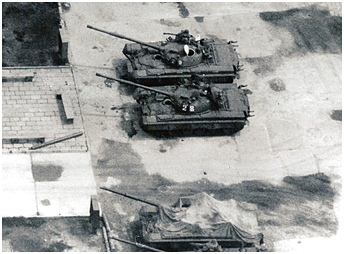 To the south of Werneuchen there were some East German installations belonging to the East German Army and the Border Guards, particularly the
barracks at Gossen where there was a 400-metre exact replica of the Berlin Wall. Here you were able to see the Border Guard recruits being trained for
duty on the Wall. It was obvious at that time that all types of scenario were being played out so that the number and variety of escapes could be lessened.
On one occasion, whilst looking in this area near Alt Rudersdorf, we came across a large area of excavation and, as usual, since it looked to be of
interest we took a few photographs. In this case we had quite accidentally come across a target of high priority. The Soviets were in the process of
installing a large aerial and burying it in the ground which would allow direct communications with the Soviet Union. Apparently, there had been
intelligence concerning such a development but nobody had any idea what to look for until the Chipmunk came across it while looking for something
else. Therefore, as a matter of routine, for the next 18 months we would visit the site about every five to six weeks to check on its progress. We managed
to record every stage of construction and this was just as well, since within two years there was no sign that anything had ever happened in the area (2).
In fact the real problem with the buried aerial system at Kagel was that it was some ten miles outside the Zone; had we been noticed doing a quick dart
outside we could have been in serious trouble.
To the south of Werneuchen there were some East German installations belonging to the East German Army and the Border Guards, particularly the
barracks at Gossen where there was a 400-metre exact replica of the Berlin Wall. Here you were able to see the Border Guard recruits being trained for
duty on the Wall. It was obvious at that time that all types of scenario were being played out so that the number and variety of escapes could be lessened.
On one occasion, whilst looking in this area near Alt Rudersdorf, we came across a large area of excavation and, as usual, since it looked to be of
interest we took a few photographs. In this case we had quite accidentally come across a target of high priority. The Soviets were in the process of
installing a large aerial and burying it in the ground which would allow direct communications with the Soviet Union. Apparently, there had been
intelligence concerning such a development but nobody had any idea what to look for until the Chipmunk came across it while looking for something
else. Therefore, as a matter of routine, for the next 18 months we would visit the site about every five to six weeks to check on its progress. We managed
to record every stage of construction and this was just as well, since within two years there was no sign that anything had ever happened in the area (2).
In fact the real problem with the buried aerial system at Kagel was that it was some ten miles outside the Zone; had we been noticed doing a quick dart
outside we could have been in serious trouble.
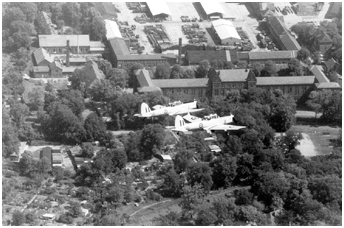
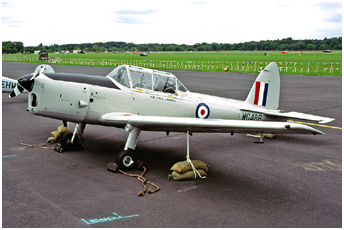 Just to the south of Alt Rüdersdorf near Zernsdorf there was a medium
sized lake that was often used by the Soviets for amphibious training. This consisted mainly of practising river crossings, building pontoon bridges and
using small ferries to transport tanks and heavy vehicles. Observing this activity was of great value when this training was seen being put into
practice at the various river crossing sites on the river Elbe such as Kehnert near Magdeburg [precisely south of Mahlwinkel]. Ground tours were not always able to observe all the
activity, and so our operations helped them to complete the jigsaw by reference to the activities at Zernsdorf.
The next landmark was the radio station at Königs Wusterhausen where there were two massive radio aerials for the East German radio system.
There had been three aerials but one of them had been blown over in the gales in the winter of 1972 and had not been replaced. To the south of the
aerials was the town of Mittenwalde where I was always intrigued to find a factory that produced naval weapons which were always out in the open
awaiting despatch. On these photographic sorties , we normally stayed well to the south of the East German airfield of Schönefeld. However, this created other
problems, particularly in bad weather as there were very few landmarks. If you flew too far south at this stage you could easily leave the BCZ and
overfly the Soviet Headquarters at Zossen-Wünsdorf, which was not to be recommended. This headquarters was the original Wehrmacht headquarters
during the Second World War and had at least seven stories underground as well as the buildings above ground.
Just to the south of Alt Rüdersdorf near Zernsdorf there was a medium
sized lake that was often used by the Soviets for amphibious training. This consisted mainly of practising river crossings, building pontoon bridges and
using small ferries to transport tanks and heavy vehicles. Observing this activity was of great value when this training was seen being put into
practice at the various river crossing sites on the river Elbe such as Kehnert near Magdeburg [precisely south of Mahlwinkel]. Ground tours were not always able to observe all the
activity, and so our operations helped them to complete the jigsaw by reference to the activities at Zernsdorf.
The next landmark was the radio station at Königs Wusterhausen where there were two massive radio aerials for the East German radio system.
There had been three aerials but one of them had been blown over in the gales in the winter of 1972 and had not been replaced. To the south of the
aerials was the town of Mittenwalde where I was always intrigued to find a factory that produced naval weapons which were always out in the open
awaiting despatch. On these photographic sorties , we normally stayed well to the south of the East German airfield of Schönefeld. However, this created other
problems, particularly in bad weather as there were very few landmarks. If you flew too far south at this stage you could easily leave the BCZ and
overfly the Soviet Headquarters at Zossen-Wünsdorf, which was not to be recommended. This headquarters was the original Wehrmacht headquarters
during the Second World War and had at least seven stories underground as well as the buildings above ground.
Notes
(1) 41.Fla-Raketenbrigade at Ladeburg.
(2) It was most likely the East German Ministry of National Defense radio transmission center in Kagel, which included a buried antenna
> Link. The transmitter "M"
operated a buried loop antenna and transmitted an identification code several times per minute, the change of which was intended to signal alarm conditions or an emergency.
 |
Safety of Flight not Garanteed < Part 1 < Part 2 > Part 4 |
 |
Plan du site - Sitemap |  |
